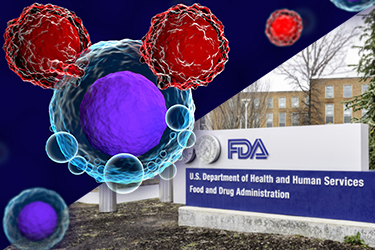FDA's CBER Issues Final Guidance For CAR T Cell Products
By Annie Lamontagne and Wendy Liang, Dark Horse Consulting Group

The FDA issued the final guidance document, Considerations for the Development of Chimeric Antigen Receptor (CAR) T Cell Products, on January 29.1 The guidance document was well-received when it was first issued as a draft in March 2022, according to the majority of docket comments posted on the Federal Register.2 Comments were prepared by various professional societies, therapeutic developers, academic institutions, and other contributors. A few significant changes were made to the document since the draft, and points of additional clarity were added throughout each section, in line with many of the comments posted.
CBER’s Office of Therapeutic Products (OTP) is hosting a public webinar on Thursday, March 7th, to review their current thinking about this topic and highlight key considerations described in the final guidance.
Overall, the CAR T guidance document provides an excellent high-level summary of key considerations for developers as they compile the data packages necessary to facilitate a successful investigational new drug (IND) application. There are a few areas of clarity provided for specific autologous or allogeneic considerations, and the document stays true to the intended scope regarding CAR T cells. Given that we now have six approved CAR T cell products in the U.S., all for hematological indications, there were few unexpected perspectives provided in the document. More specific recommendations and examples for a broader selection of T cell-based therapies, non-T cell therapies, and non-oncology indications are not addressed in this document and represent gaps in current industry guidance.
Introduction And Background
The document is structured with recommendations to support developers in the design and development of CAR T cell products, with emphasis on oncology indications. Despite requests or comments from several groups, there were no changes made to include recommendations for non-oncology indications and clarification of the scope was a specific change made in the final document.
The final guidance is further clarified with an emphasis on ex-vivo manufactured CAR T cell products, as suggested in docket comments submitted by the Alliance for Regenerative Medicine (ARM). Design and development considerations for in-vivo gene editing drug products are described with minimal detail in the recently issued industry guidance on gene editing,3 thus their exclusion from the scope of this document represents a notable gap in the field with respect to understanding the agency’s current thinking on in-vivo gene editing products.
General Considerations For CAR T Cell Design And Development
The docket comments focused particular attention on the subsection on cellular starting material, regarding the prominence of recommendations for patients who may have received previous CAR T cell treatments. The draft guidance recommended testing of the leukapheresis product to evaluate the presence of prior CAR T cells and of the final drug product to determine the level of new and prior CAR T cells. Most of the submitted comments provided feedback that the recommended testing would be challenging, if not impossible, without knowledge of proprietary design elements of the transgene or vector sequence to design appropriate test methods. In the final guidance document, this section is notably reduced, with omission of the specific recommendations for testing of the final drug product. A suggestion for testing of the cellular starting material by “detection of common vector or CAR features” remains. A recommendation to include starting material retains was incorporated, but no further clarification was provided for what type of testing may be considered sufficient. The agency recommends sponsors discuss considerations for testing with OTP. There is limited information available on the design of test methods that would facilitate detection of unidentified integrated CAR sequences, but an interesting approach was described by Wiltshire et al. (2021) using a ddPCR assay to quantify integration of the replication response element (RRE) as a surrogate for the transgene element.4
Recommendations pertaining to the eligibility of patients who received prior CAR T cell treatment were removed from the final guidance document, with a point made to discuss clinical study design with OTP as part of a pre-IND meeting.
Several clarifications were added throughout the remainder of this section in response to comments posted collectively through the ARM working group and others.
- CAR Construct: Flexibility was added for functionality of the signaling domain to be supported through previous nonclinical and clinical experience, in addition to demonstration as described in the Nonclinical Recommendations section.
- Vector: A more inclusive description was included to identify a “vector” as the vehicle delivering genetic material.
- Vector: Additional clarity was provided to include examples of unnecessary transgenes that should not be included, such as antibiotic resistance genes.
- Fresh or Cryopreserved Final Products: The consideration for in-use stability was explicitly called out due to the potential impact on product shelf-life and quality.
- Fresh or Cryopreserved Final Products: There is specific inclusion of the controls in place to ensure product quality during transportation to the clinical site, such as procedures to describe “shipping, receipt, storage, and preparation for infusion.”
CMC Recommendations
This section included many changes to the final guidance document from the draft guidance, but the overall messaging is largely unchanged. Rather, language was refined to ensure the intent was made clear.
Vector Manufacturing and Testing
Clarity was added to indicate that “vector safety and quality should be sufficiently characterized” for clinical investigations. Additionally, it was noted that the vector must be manufactured according to cGMP for “later phase studies and for licensure”. Here, again, the agency has used a more inclusive definition for vector, but despite direct comments from multiple groups there was no clarity added to describe manufacturing requirements for critical gene editing components such as plasmids. The recent gene editing guidance document3 suggests developers follow principles described in the guidance document for Phase 1 investigational drugs,5 but the recommendations in both are quite generalized on this point.
Whereas the draft guidance included “potency” in vector lot release testing, the final guidance used the phrase “biological activity”, but the principles were unchanged.
Collection, Handling, and Testing of Cellular Starting Material
Several points from the docket comments specific to this section were incorporated into the final document. For example, a disclaimer was added that although donor eligibility determination is not required for autologous leukapheresis material, a “risk-based approach for screening or testing” may be considered to ensure environmental health and safety of manufacturing operators and facilities.
In response to multiple comments, the statement was added, “Once the leukapheresis starting material has been received by the manufacturing facility, subsequent manufacturing must comply with cGMP as appropriate for the stage of development.” This adds sufficient clarity regarding the agency’s current thinking on cGMP requirements for cell collection procedures.
CAR T Cell Manufacturing and Testing
The totality of changes in this section remains largely minor and seems to be driven by docket comments posted that indicate a lack of clarity. Points of note include:
- Clarification that appropriate methods for qualification of ancillary materials should be determined per a risk assessment.
- Clarification that manufacturing should be performed under a qualified aseptic process, with aseptic process validation required for licensure.
- Addition that “In-use stability studies should be conducted to support the intended hold time between final formulation and administration for fresh products, or the time between thaw and administration for cryopreserved products.” For those counting, this is (at least) twice that in-use stability studies are specifically mentioned in the final guidance document. This is not a new requirement but may represent a matter that has been overlooked in submissions reviewed by the agency.
- The draft guidance recommended CAR T cell stability studies include patient material for more accurate assessment of the product shelf-life; however, this was softened in the final document to acknowledge that stability studies using healthy donor material are acceptable in early-phase studies.
Very few changes of note were made throughout the analytical testing section. There was some finessing of language regarding CAR-expressing versus CAR-positive cells for vector copy number (VCN) calculation, but the recommended strategy for determining VCN is unchanged. Flexibility was added regarding justification of specification for VCN, specifically, the allowance of development and engineering runs as supporting data, and a few expanded examples were provided for evaluating potency when CAR cells express multiple transgene elements.
There were no significant changes in the remaining subsections describing manufacturing changes and comparability and single vs. multi-site manufacturing. This is likely a reflection of the agency’s focus on finalization of the draft guidance on Manufacturing Changes and Comparability for Human Cellular and Gene Therapy Products,6 which is currently listed on CBER’s 2024 Guidance Agenda.
Nonclinical Recommendations
There were no major changes to the content of the nonclinical recommendations. Notably, in this section and throughout the guidance, the term “preclinical” was replaced with the term “nonclinical”, which is in alignment with the Food and Drug Omnibus Reform Act of 2022 (FDORA).
Clinical Recommendations
In the final guidance, FDA provided clarifications that generally afforded more flexibility to sponsors. In addition, the final guidance underscored the importance of a funded long-term follow-up plan.
Study Population
Regarding pediatric subjects, multiple groups commented that it may not be practical to collect initial safety and tolerability data in adults before initiating some clinical studies in children. As noted by ARM, there may not be evaluable adults for certain indications. In the final guidance, FDA stated that initiating trials in children before obtaining safety/efficacy data in adults could be appropriate with justification and included a reference to the September 2022 draft guidance titled Ethical Considerations for Clinical Investigations of Medical Products Involving Children.7
Treatment plan
In the draft guidance, FDA initially recommended calculating CAR T cell dose based on body weight/body surface area (BSA), rather than using a flat dose. The Center for Cellular Immunotherapies at Penn Medicine (CCI) requested FDA to reconsider this recommendation in their docket comments, based on their experience using weight-based dosing in adult solid tumor trials. FDA accepted this request and, in the final guidance, recommended sponsors propose dosing strategies based on appropriate justification.
FDA softened its initial stance on continual reassessment methods (CRM) for first-in-human (FIH) dose-escalation studies, stating that these methods may be appropriate with appropriate justification. A CRM is a model-based design for Phase 1 trials, as opposed to the rule-based 3+3 design. A model-based design may lead to faster dose escalation, which can be desirable for sponsors. On the other hand, faster dose escalation may pose risks to patient safety, thus appropriate justification will be required for use of CRMs.
Safety Evaluation and Monitoring
The FDA removed its recommendation to monitor cytokine levels in patients at baseline and at prespecified time points. Docket commenters pointed out that blood cytokine level results may not be available in time to make treatment decisions and that blood cytokine levels are not typically used to guide current cytokine release syndrome (CRS) management algorithms.
CAR T Cell Persistence and Long-Term Follow-Up
A notable addition to the end of the clinical section was FDA’s recommendation to provide a plan “for follow-up, including funding, in the event the sponsor ceases to operate or decides to inactivate, transfer, or withdraw the IND before completion of the long-term follow-up.” Sponsors should note that FDA will be expecting a contingency plan that includes funding to complete the long-term follow-up study protocol.
Additional Findings:
- FDA maintained its recommendation for parallel-dose escalations in early-stage tissue-agnostic studies, despite requests from commenters to endorse a basket trial approach.
- FDA added psychiatric toxicities to the list of toxicities to monitor.
- FDA added Grade 3 and greater neurotoxicity to the recommended list of treatment-emergent dose-limiting toxicities (DLTs).
- FDA added that it recommends DLTs be defined independent of attribution to CAR T cells unless a clear alternative cause can be described.
References
- U.S. Department of Health and Human Services, FDA, CBER (January 2024). “Considerations for the Development of Chimeric Antigen Receptor (CAR) T Cell Products, Guidance for Industry”. https://www.fda.gov/media/156896/download
- Public comments posted to Docket ID: FDA-2021-D-0404: https://www.regulations.gov/docket/FDA-2021-D-0404
- U.S. Department of Health and Human Services, FDA, CBER (January 2024). “Human Gene Therapy Products Incorporating Human Genome Editing, Guidance for Industry”. https://www.fda.gov/media/156894/download
- Wiltshire, T.D., Milosevic, D., Jacob E.K., Grebe, S.K., and Dietz, A.B. “Sensitive detection of integrated and free transcripts in chimeric antigen receptor T-cell manufactured cell products using droplet digital polymerase chain reaction.” Cytotherapy (2021) 23: 452 – 458. https://doi.org/10.1016/j.jcyt.2020.12.012
- U.S. Department of Health and Human Services, FDA, CDER, CBER (July 2008). “Guidance for Industry: cGMP for Phase 1 Investigational Drugs” https://www.fda.gov/media/70975/download
- U.S. Department of Health and Human Services, FDA, CBER (July 2023). “Manufacturing Changes and Comparability for Human Cellular and Gene Therapy Products, Draft Guidance for Industry” https://www.fda.gov/media/170198/download
- U.S. Department of Health and Human Services, FDA, OPT, CDER, CBER, CDRH (September 2022). “Ethical Considerations for Clinical Investigations of Medical Products Involving Children, Draft Guidance for Industry, Sponsors, and IRBs” https://www.fda.gov/media/161740/download
 About The Authors:
About The Authors:
Annie Lamontagne, M.S., is a senior consultant at Dark Horse Consulting Group. She has more than 20 years’ experience, including over 10 years exclusively in the C & GT field. Lamontagne’s experience ranges across academia and industry with expertise in cell processing, process optimization, clinical manufacturing, technology transfer, and CMC regulatory support.
 Wendy Liang is a consultant at Dark Horse Consulting Group. She started her career in C & GT at Juno Therapeutics (now Bristol Myers Squibb), where she worked on the process development of multiple CAR T and TCR therapies. Liang has supported DHC clients on their process development, technology transfer, regulatory authorship, and gap analysis needs since joining the practice in 2021.
Wendy Liang is a consultant at Dark Horse Consulting Group. She started her career in C & GT at Juno Therapeutics (now Bristol Myers Squibb), where she worked on the process development of multiple CAR T and TCR therapies. Liang has supported DHC clients on their process development, technology transfer, regulatory authorship, and gap analysis needs since joining the practice in 2021.
